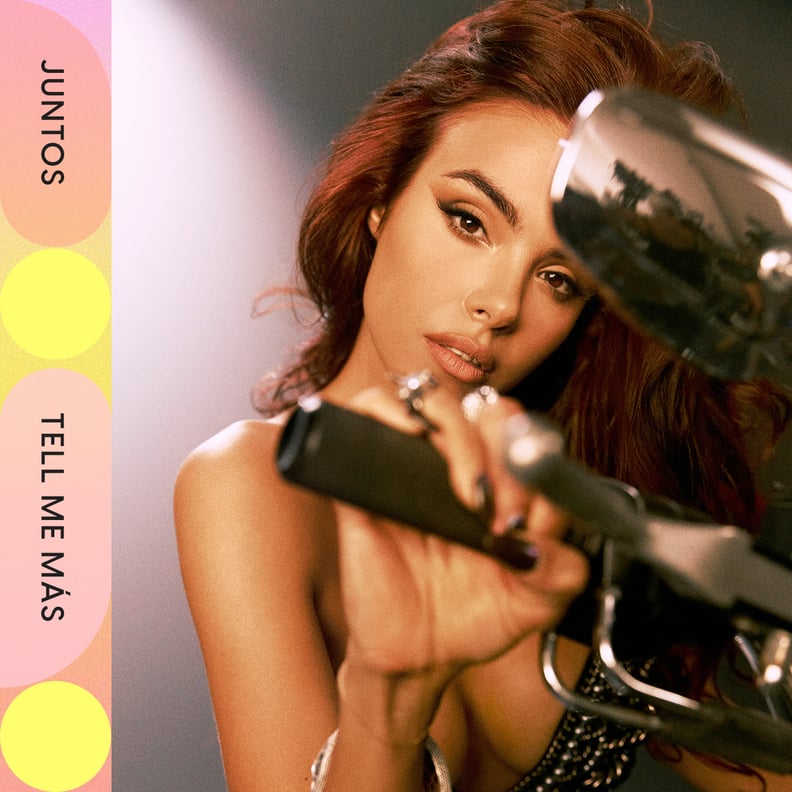
 Greg Swales/Design by Keila GonzalezGreg Swales/Design by Keila Gonzalez
Greg Swales/Design by Keila GonzalezGreg Swales/Design by Keila Gonzalez
In the music video for her piano-driven interlude “Bambi,” Bodine poses in the middle of a dense forest, artistically garbed in assorted animal bones as she croons over the black and white footage with an ear-catching voice that straddles mezzo and alto ranges. The visual doubled as an announcement video for her sophomore EP, “Quemo Lento,” which dropped last month. Still, if anyone got the impression the project would hinge on somber instrumentals, her other tracks quickly proved them wrong. The follow-up singles “No Me Quiere Más Na'” and “Nalgaje” present a saucier and more liberated version of Bodine. But who is the real Bodine? Is it the contemplative, artsy soul hinted at in the first track, or the one who takes pride in homaging vedette Iris Chacón and singing catchy odes to booties? The answer is unsurprising to those who know her — she’s both.
Born in Amsterdam, Bodine Koehler Peña and her family relocated to Puerto Rico when she was 8, and that’s where she spent her formative years. After a brief stint in a Catholic elementary school in Old San Juan, she enrolled in the Escuela Especializada en Ballet Julián E. Blanco. The institution offered an opportunity to learn both traditional courses and dance.
“We trained from 7:30 in the morning until 11:30, and then took a shower, [ate] lunch, and had academics until 5,” she says. Bodine doesn’t hesitate to refer to herself as having been a “wild child” during her early teenage years, spurring her mother into finding another outlet for all that energy.
“I never followed rules,” she says, slyly grinning. “And my mom was like, ‘Wow, I have to find things for her to do, to really keep her off the street.’ I was making too many friends too fast.”

 RelatedRelated
RelatedRelated
Bad Bunny's First NYC Show From His Most Wanted Tour Is Proof His Latine Fans Still Come First
Her solution wasn’t far away: an old piano they had in the house often grabbed Bodine’s attention. “I would always sit down and play some disparates,” she laughs. Noting her interest in music, her mother got her formal piano classes at San Juan’s Department of Art and Culture. Soon after, her grandfather helped cover the costs of enrolling her at the Puerto Rico Conservatory of Music, where she eventually took courses in piano, songwriting, and opera singing.
During this time, Bodine gained what she today calls a “survival instinct” that she’s harbored ever since. Her family relied primarily on public transportation, but the surplus of classes she was taking meant her days ended late. She and her mother would walk dimly lit streets and bridge underpasses to bus stops, often paying with coins they had scrounged up. Far from the façade of the carefree, impossibly beautiful model that came later, Bodine looks back at those days as tinged with uncertainty and worry. To hear her tell it, her ambitions were born from a desire to protect her family, whom she saw was sacrificing so much for her.

 RelatedRelated
RelatedRelated
Shakira Thinks the "Barbie" Movie Is Emasculating — Here's How She Missed the Point
“It was a necessity. The way it came to me, it was not even me really looking for it,” Bodine says. “I was just like, ‘I have to take care of my mom.'”
Her most significant break came at the young age of 13 and resulted from a spur-of-the-moment decision. As she tells it, on an inspired whim, she walked into the Calle Loíza offices of notable Puerto Rican fashion designer Harry Robles and declared herself his next model. Her spunkiness and confidence impressed Robles, and the very next day, she had the gig. This was the first step on the path that led to her becoming Miss Puerto Rico and participating in Miss Universe 2012 in front of millions.
While she tries not to dwell on her years as the reigning Miss Puerto Rico and her experiences afterward as a budding model in New York City, especially in light of the more upbeat and optimistic flavor of “Quemo Lento,” she shares that that phase of her career created an arc that has molded her into who she is today. She’s proud of the work, but readily admits she took the opportunity because of its benefits.
“The reason I got in there was they told me, ‘Hey, you will get some money. You will get a car.’ And I needed [to pay for] school, I needed a car, I needed to buy books, I needed to help my family,” she says. What came after her participation in Miss Universe was another deck of cards, one that didn’t turn out in her favor. According to Bodine, these days, women who are successful in pageants go on to appear in TV shows or receive greater opportunities for their careers. But in her time, she says, “it wasn’t like that.”
“I had to provide for my family, for myself, and so I had to leave and hustle.”
She continues: “You finish, and then you’re like, ‘I need work, I need an income.’ So I had to go get that. I had to provide for my family, for myself, and so I had to leave and hustle.”
Bodine doesn’t water down the disillusion she felt. “It was a lot. I had a lot of people around me [those days]. I had a lot of ‘friends’ around me. And the truth is I was 17, 18, 19 when all this happened,” she says. When she returned to fending for herself, reality became a cold splash in her face. “That’s when you know who your friends really are. I had no support. All my ‘friends’ were not my friends. And that gets really lonely. That was lonely, and very disappointing, and very heartbreaking.”
The sometimes toxic negativity from the press and public that threatened to overshadow her reign was also disheartening. These days, she tackles it in a more holistic manner despite agreeing that the media’s hyper-focus on “messy” celebrities tends to be cruel.
“It is cruel. And I think I just knew that it was part of the process. When you’re in the public eye, you need to understand that you just need to really be passionate about what you want in your life and speak to that, because no matter what, there’s always going to be negativity,” she says. “There’s always going to be people who try to push you down.”
Even back then, Bodine was aware of the particular vitriol reserved for women, especially young women, who were scrutinized more than the average person and were given less leeway and grace to make mistakes. She’s thankful she got through it, and more so that there is accountability now that didn’t exist back then.
“I think all women were in a situation where they were completely vulnerable. And hey, bad timing, I guess. I think today not everybody can say whatever they want about particular women,” she says. “Back then — this is before the #MeToo movement — you could say anything and everything. And I’m sure a lot of girls experienced that, not only in my world but in [other industries].”
Her post-Miss stint as a model was also rocky and uphill at the start, owing to that same lack of support. “I didn’t know anybody. I had no agency. I applied [and] everyone said no to me. I applied to more than 20 agencies, from the most deep dungeon ones to the top. And they all said no,” she says.
The situation became so dire it began to resemble an absurdist comedy at one point. “I remember I was so stressed that I had so much acne all over. I was so stressed I literally grew a beard,” she laughs. “I was so desperate for work that I went to the booker, and I’m like, ‘Listen to me. I need a job. I need to get booked. I’ll do anything. I could do [a] Proactiv campaign. I can do anything, I can do even Gillette.'”
As fate would have it, she did eventually get signed, and steady work began to arrive. Still, the phantoms of her past and her survival instinct never went away. Twelve years and two albums later, Bodine looks back on what has led her to today with a mix of gratitude and melancholy. “Celos,” her underrated first EP, was imbued with a darker sound, even when it was trying to be a joint that could still pass as sensual and club-worthy. The reason for that is clear in hindsight.
“It was a time I was really depressed,” she shares. “I was about to . . . stop being in the industry.” She ran into the same roadblocks that had pestered her for over a decade since her pageant days. Namely, people trying to box her into a persona that was nowhere close to who she felt she was. It’s a big reason she’s maintained being an independent artist so far.
“I didn’t submit [to industry pressure],” she says. “So that project was born from a place of restarting all over.”
She’s still striving to grow as an artist, and just as oysters create pearls from irritants that invade their system, Bodine sees everything she went through as a process that has made her more formidable than ever as a woman and a creative. She credits meditation as one of the most significant tools that helped her harness her experiences positively, saying she took it up early in her career because “there was a lot of waiting time” to indulge in it. But she also says she feels thankful for her art when it comes to shooting down any criticism or negativity.
“I feel protected by music. I think that music, my work, will always talk for me,” she says. “Quemo Lento,” with its varied offering of genres and eclectic guest artists, tells the world that she’s feeling much more optimistic.
“I’m in a good place — happy and really proud, and finally doing what I’ve actually wanted to do my whole life. I wish I were here before, but I just know it wasn’t my time yet,” she says. “I had to go through this whole thing to help my family and change my circumstances. And it was tough, but we’re here now.”
It might’ve been a slow burn, but she’s made it and is ready for what’s next.
Juan J. Arroyo is a Puerto Rican freelance music journalist. Since 2018, he’s written for PS, Remezcla, Rolling Stone, and Pitchfork. His focus is on expanding the canvas of Latin stories and making Latin culture — especially Caribbean Latin culture — more visible in the mainstream.

